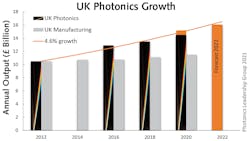The morning panel started with Dr. John Lincoln of the Photonics Leadership Group providing a mix of current stats and insights around the photonics market in the UK, adding granularity and rounding out the information provided by Sage Policy Group’s Dr. Anirban Basu, Bos Photonics’ Dr. Bo Gu, and Dr. Arnold Mayer in the previous morning sessions.
One insight that stood out—Lincoln’s projection based on current numbers by industry and ongoing trends. “We generated one of the first forecasts about where photonics will be not in two or three years, but in 2030/2035. That will make it as big as the automotive industry currently is in the UK,” says Lincoln. “That’s a big, dramatic increase...and a lot of additional jobs. A huge amount of the economy will depend on photonics and lasers to keep it productive.”
Lincoln added a current program within the UK could help in addressing the projected job growth (see figure). “We have a new global talent visa, that means that essentially, anybody with a PhD anywhere in the world can now get a visa to come and work in the UK,” he says. “It is now easier to hire global talent into the UK from anywhere.”Chips in the market
Addressing a question about the recent Intel announcement of its plan to build a chip facility in Ohio, Basu projects the market will be flooded with chips. “What we see is the pendulum swings back and forth to go from shortage to surplus all the time whether it's oil or steel running commodities, but I think ultimately that will happen with chips,” he says.
According to Basu, Intel’s decision has significant economic and geopolitical consequences, especially since the new plant could have been a project that was outside the country. “They could have invested almost anywhere in Malaysia. Anywhere—but they chose Columbus, OH. The great industrial Midwest,” he says. “More American chip capacity for jobs here, less dependence on Taiwan, less strain on global supply chains, more innovation, and probably more worker training.”
Better understanding China
Gu provided insights into doing business in China. IP is important, and companies need to take the steps necessary to protect their patents. “You should apply for a worldwide issue first, which will give you the rights to eventually file in China,” says Gu. “In another five years, Chinese IP protection will be critical because that’s in the interest of the Chinese company as well.”
Gu also discussed the importance of understanding that Chinese companies are at a different level in their capabilities than many anticipate. “You really will be surprised how advanced they are.”
Supply chain challenges
Ralf Kimmel from Trumpf Laser Technology joined in the discussion, pointing out that COVID-19 did not ultimately have the impact on the photonics market that many initially feared. “There is more of a challenge in the supply chain, which we see like all the others,” he says.
According to Basu, it is understandably hard to extricate COVID-19 from the supply chain issues—and for good reason. “When you’ve got China shutting down the third largest container cargo port in the world or Malaysia shutting down semiconductor manufacturing for the auto sector because they’ve had a breakout of COVID, then you’ve got the supply chain issues,” he says. “The notion is that at some point, supply/demand imbalances will go away.”
It’s also important to note when the U.S. issued stimulus payments, consumers not only wanted electronics (often made in China), they had the money to spend and time at home. “It created demand that even under the best of circumstances, the supply chain could not handle that,” says Basu. “Now, for a post-pandemic world, the supply/demand balance won’t be as bad. Moreover, suppliers have expanded capacity, and they have made investments. You should see much smoother supply chain operations.”
Paying attention to Net Zero
Sustainability and green are not only important today, they will continue to grow in significance, explains Lincoln. “We see a dichotomy between their very long-term planning government and a much shorter-term cost. I am anticipating the need to try and align those two,” says Lincoln. The move towards sustainability is happening. The question is, “how long before that drills down to asking deep questions in the supply chain and making choices about suppliers on how environmentally friendly you are, not just how expensive you are.”
“I’d love us to get to net zero, but I’m concerned that we’ll get to zero before we get to net zero,” says Basu. Why? What Basu refers to as the unknown unknowns or Black Swan events with low probability, but when this happens, the really significant effects can have very long-term impacts. “Is it North Korea, Taiwan, Ukraine? Cybersecurity, assault on the U.S. financial sector? Whatever it happens to be really concerned about that,” he says.
CONTINUE READING >>>
About the Author
Peter Fretty
Market Leader, Digital Infrastructure
Peter Fretty began his role as the Market Leader, Digital Infrastructure in September 2024. He also serves as Group Editorial Director for Laser Focus World and Vision Systems Design, and previously served as Editor in Chief of Laser Focus World from October 2021 to June 2023. Prior to that, he was Technology Editor for IndustryWeek for two years.
As a highly experienced journalist, he has regularly covered advances in manufacturing, information technology, and software. He has written thousands of feature articles, cover stories, and white papers for an assortment of trade journals, business publications, and consumer magazines.


